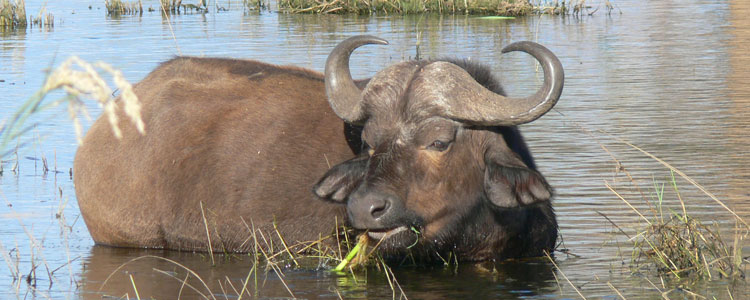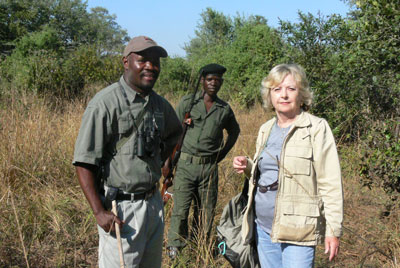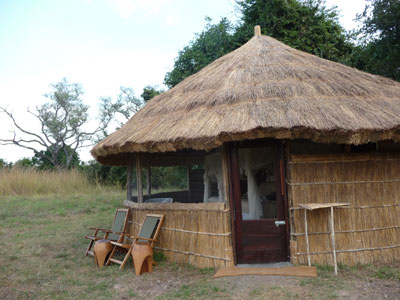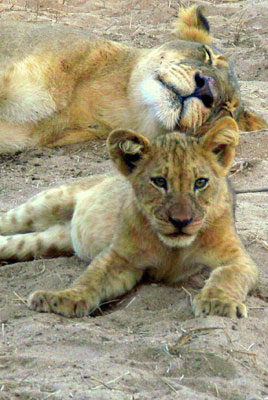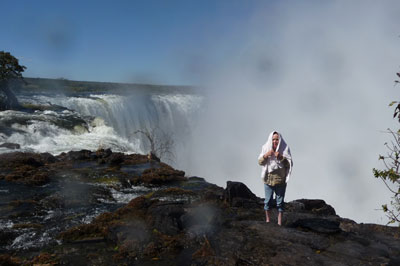A breathtaking private tour of Zambia
by Regine Schumacher, Seal Beach, CA
Someone once said that life is not measured by the number of breaths we take but by the places and moments that take our breath away.
Geographic Expeditions, my favorite tour company, arranged a private trip for my friend Thelma and me to Zambia (formerly Northern Rhodesia) which took my breath away many times.
A great beginning
In June 2010, after a very long flight, we arrived in Lusaka, the capital of Zambia. From there we were whisked away by small plane to a tiny airport at Mfuwe, then driven to Mfuwe Lodge in South Luangwa National Park. The lodge is quite famous for the herds of elephants that migrate in late fall right through its lobby and common areas in order to feast on the ripe mangoes on the other side.
We had our own luxurious tent, built on a wooden platform, which included comfortable beds with mosquito netting; charming furnishings, and a private bathroom with modern appliances, a shower and an old-fashioned footed tub. Right in front of our veranda was a swamp full of hippos and crocodiles.
Monkeys and baboons were everywhere, and it was a delight to see them jumping from tree to tree with their babies clinging to their backs or bellies.
Each day consisted of a Continental breakfast at dawn followed by a walking safari. I had been to Africa on safari many times before, but actually walking on the animals’ territories added such a new dimension and experience to the usual safari by vehicle — quite an unforgettable feeling!
We walked single file so as not to disturb the animals too much. Our guide was in front, a ranger followed him and we followed in the middle. At the end, a porter carried refreshments.
Of course, most animals one sees during the day are vegetarians and rather shy, but Cape buffaloes can get nasty, and on cloudy, cold days hippos — particularly dangerous — might still be about. (Usually, they stay in the water during the day to shelter their sensitive skin from the sun.)
Elephants can be very aggressive also, especially if they are protecting their babies. Teenagers in a herd can be rambunctious, and any member might fight anything or anybody they see as a threat to their territory. We made wide circles around the herds.
Following our stay at Mfuwe, we spent two nights at each of two classic bush camps, equipped with “safari drum” showers — quite rustic accommodations but extremely comfortable.
Again we went on morning walks, enjoying the scenery and the immense baobab trees that can reach over 2,000 years in age. Brunch was at 11, with a siesta afterward, tea at around 3:30 and then a driving safari in a Land Cruiser or similar vehicle for game viewing. After dark, one of our guides used a spotlight to detect nocturnal animals. We saw hyenas, civets and leopards plus lions feasting on their latest kills.
Of course, we saw lions and leopards during the day also, but they were mainly sleeping and digesting then and were aroused only when vultures or hyenas tried to steal their kills. I cannot recall all of the wildlife we saw, but zebras, giraffes, impalas, waterbucks, pukus, mongoose and a huge monitor lizard come to mind.
Lower Zambezi
After our adventures in South Luangwa, we flew to the Lower Zambezi region. We landed on a dirt airstrip, then took a fairly long drive to a boat landing, continuing by boat down the Zambezi to Chiawa Camp, one of only a few camps permitted to operate in the stunning Lower Zambezi National Park.
This has become one of Africa’s most exclusive safari destinations — truly a special place. Located right on the river, the camp had special boats, canoes, fishing gear and vehicles for the enjoyment of its guests.
As before, we took morning walks and afternoon/evening safaris. Lots of elephants wandered through the camp, and a hippo decided to mark its territory by spraying feces over a bush right next to our tent, not totally missing the few steps to our tent. Baboons jumped on the tent or threw nuts, enjoying the racket they created.
At Chiawa we were treated to a champagne lunch on a boat and had a great view of the animals inhabiting the river or its banks — mostly hippos, crocodiles and Cape buffaloes — as we glided by. At night there was a campfire for the guests. It was fun exchanging stories about our sightings.
From Chiawa we flew by small plane back to the capital before continuing on to Livingstone. When the plane to Lusaka arrived about 45 minutes late, the pilot said he had to make a minor adjustment. He took the cover off one of the engines and, with a pair of pliers, started to work on his “adjustment.” It didn’t work.
There was no facility of any kind around, but after a while a safari driver provided a short wire. Again the pilot worked on the engine, finally saying that it “should” hold.
I wasn’t thrilled with the word “should,” but we took off, arriving safely in Lusaka. As a friend of mine used to say, “Every flight that does get you back on the ground is a good flight.”
We were on time to catch our flight to Livingstone, located near Victoria Falls.
Lasting impressions
Victoria Falls is the largest waterfall in the world and in many ways is unique. It has a vertical drop more than twice as high as and twice the width of Horseshoe Falls at Niagara.
In the middle of the falls is a very small island, situated right on the precipice of the falls. Only a few people are allowed on this tiny island. We were so incredibly lucky to be among the rare visitors, thanks to the arrangements made by Geographic Expeditions.
It felt strange to head by boat in the direction of the water flowing over the enormous waterfall, even if the boat did have two motors.
When we arrived at the island, we had to take off our shoes and put towels on our heads to protect us from the spray (though I'm glad someone suggested bringing a change of clothes because we were soaked by the end of our visit). Then we were led through mud and slippery rocks to the center of the falls, right to the edge.
Looking down the vertical drop was like looking into an abyss of foaming water. It was frightening and beautiful at the same time. The overwhelming power of nature and its awesome beauty, framed by spectacular rainbows, was unforgettable.
Back at Toka Leya lodge, Judi and Arthur, representatives of Geographic Expeditions, told us fantastic stories about their life in Zambia, where they’ve lived for over 15 years. Then, to our delight, they invited us to visit their chicken farm, Nkuku, an incredible operation.
They supply lodges and restaurants with chickens, and Judi and Arthur make their own compost from chicken droppings, which they either sell or supply to the local farmers in order to “give back” to the community. They also have a nursery, where they use the compost to raise native trees from seeds to saplings for reforestation of the local area.
Despite wide cultural diversity, Zambians seem to live in peace and harmony with each other — an ethos reflected in the nation’s motto: “One Zambia, One Nation.”
Zambia is one of the few countries in Africa with little, if any, tribal animosity. Its people are very proud of their united and peaceful heritage.
The land cost for this private 13-day tour was $8,475 per person, double, plus an additional $1,880 each for internal flights and $450 per person for park and conservation fees.

